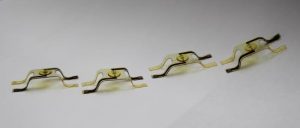For my computational digital fabrication project, I found a 3D printing self-folding electronics project. As the name explains, the project focuses on 3D printing structures that can fold up on their own.

They use various techniques such as a structure that folds as a reaction to water or a structure that buckles and compresses due to changes in membrane of material in certain areas. The point of the project is that the mechanisms causing the material to fold are introduced during the 3D printing process. Once 3D printed, the piece already has the ability to self-fold. I find it interesting how the self-folding aspect is integrated into the piece as it is printed. A more robotic self-folding mechanism would be made up of multiple pieces with complex structures, electronics and programming. However, this is a much more advanced, intricate alternative. It introduces more scientific aspects, looking in depth at the formation and structure of the material and experimenting with various ingredients.
![[OLD FALL 2017] 15-104 • Introduction to Computing for Creative Practice](wp-content/uploads/2020/08/stop-banner.png)